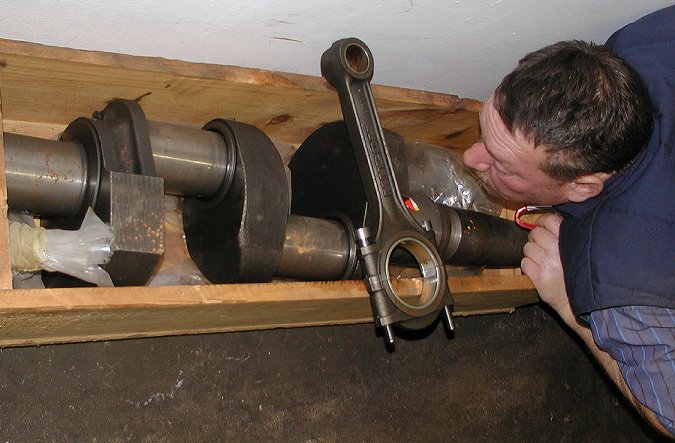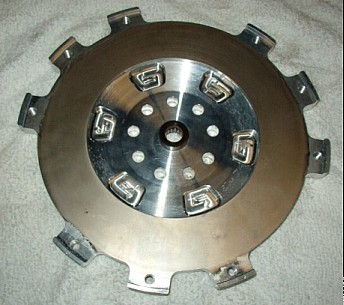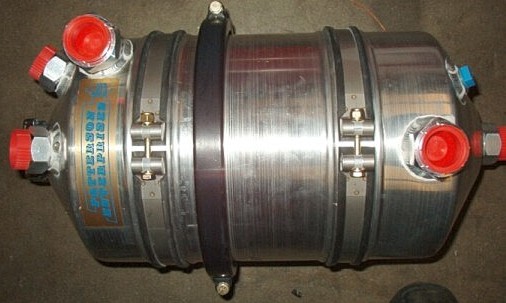

The joys of operating the Bushwacker Racecar up to this point included diehard reliability. Turn the key, push the button and race. That changes when you decide to step up to a full-race motor. Gone are the days of 200 hours between rebuilds, oil changes every few races, etc. So, our design paramaters were:
After long discussions with the owner, Ken Boyd, we settled on a motor design and began the work of collecting parts, machining components and assembly. First, the Specs:
This is what's called an "over square" or "short stroke" design which should safely allow higher revs and a torque curve that is quite wide. The pistons come from a 3.8L RSR motor and the crank & rods are out of a 3.0L motor. You'll notice the 69.4mm stroke on the engine; to achieve this, it is necessary to destroke (or grind down the journals) on a 3.0L crank. Easier said than done, but since Boyds has 5,000 cranks in stock that they've done work on - no big deal. Magaflux it first to check for cracks, grind down 1mm of journal material, then knife-edge it, balance it, and polish it.
After the Laguna race, I decided to tear into the motor to find out what happened:
I tore it all the way down - split the cases.
Remove all the heads
Inside the old motor I found:
3 broken valve springs. DON'T ever use aluminum valve retainers.
One broken rocker arm, 2 broken case studs.
A couple of bent valves from hitting the pistons.
My crewchief, Jay Jarvis, got a new job at Boyd's Enterprises just outside of Modesto, CA. This outfit builds high-performance race engines for professional NASCAR teams. They do ALL machine work onsite and have EVERYTHING you can imagine to build a race motor. They havn't worked on Porsche engines before but to them, it's just an air-pump. Their labor rates are extremely competetive and because they work on motors that don't begin w/ the letter "P", they're used to dealing with cheapskates like me. So, with BOXES and BOXES of engine parts, I dropped everything off at Boyd's.
The car sitting at Boyd's, waiting for a new motor.
My crewchief, Jay Jarvis with some crank.

Jay with some more crank. Now THAT's a crank :)
Crank magnaflux tester. This machine tests for cracks that cant be seen by eye.
A few cranks that are already done. There's another whole building full of them.
The journal grinding machine.
Crank polishing machine
A machine for welding cranks to add material or fix problems.
Boyd's also has another business, Valley Balancing. They can balance anything.
So, they know their stuff when it comes to balancing cranks.
The heads needed to be completely flowed, ported & polished.
We got 24% more flow through the intake than stock which is pretty darn good.
Valves are 3 way cuts on an in-house Serdi 100 machine.
We used Pauter rods but if we needed any rod work done, again
Boyd's is the place to go:
Thousands of rods.
Thousands more rods.
They even have a CNC machine for making custom parts.
T he completed long block. Lots of attention to detail, including painting the
case.
Next stage - wiring and bolting all components to the engine:

I hand-built the wiring harness from scratch. I called up Raychem, got ahold of a field engineer and had him bring us a huge selection of wiring harness parts. He even gave us a full tutorial on building harnesses. It didnt hurt that he used to consult w/ Formula One on their harnesses so I was using all the same stuff. It even worked the first time we put it on the dyno!

The new, super-secret lightweight flywheel. 3 something lbs.
Our recon photographer got this shot just before being bolted onto the motor...
New SCARGO Racing Headers, heat coated and ready to install

4 Gallon oil tank goes in the front trunk to replace the rear mounted one.
And the last piece - move the REDLINE!! From 7200 to 8200 : )